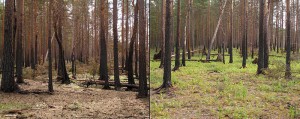
Ecological succession refers to the slow process of change in an ecological community resulting to an end of an existing one and the development of a new community. Â This change may be caused by several environmental factors including earthquakes, fires, and volcanic eruptions. The basic feature of ecological succession is that an existing ecosystem or ecological community is gradually replaced by another by way of natural occurrences and happenings.
Ecosystems may gradually changed and become new ecological communities through either primary or secondary types of succession. Â Primary change or succession takes place when a new ecological community results from primary factors such as exposure of new land surfaces that occur gradually for a long period of time. Â When these surfaces become exposed, they slowly become viable for new plant growth and this will signal the start of the development of the replacement or succeeding ecosystem.
Secondary types of ecological succession meanwhile develop from severe disturbances in an existing ecosystem. Â A typical example of this occurrence is a large forest fire. Â When fire ravaged an entire forest or ecosystem of trees for example, not much may be left in the outcome. Â All trees and plants may have been burned down to the ground causing the end of the existing ecosystem. Â Over time, as the rain falls on the ground, some grasses and mosses may grow and develop into bigger plants. Â Some trees will also slowly grow and start the restoration of the ecological community. Â With more and more plant life being restored, many animals will also come back to make this new forest as their home. Â The old ecosystem including plants, trees, and animals will slowly get restored to a new community. Â Once the whole ecosystem is fully restored and becomes viable and useful, it is considered to have reached the climax of an ecological succession.










Leave a Reply